Scientific Name: Rattus norvegicus
Common Name: Norway rat, brown rat, common rat
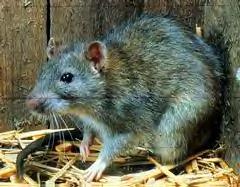
Scientific Name: Rattus norvegicus
Classification:Author: Maria MaustPhylum or Division: Chordata
Class: Mammalia
Order: Rodentia
Family: Muridae
Subfamily: Murinae
Identification: Norway rats typically have coarse, brown fur with a pale gray or grayish brown underside. They have small eyes, naked ears, and a scaly tail that is shorter than the length of their head and body. Mature rats are range between 150-300 grams and about 400 mm long. The females have 12 mammae.Original Distribution: Rattus norvegicus are native to central Asia and believed to have come from Northern or Northeastern China. They did not come from Norway, as their name suggests, but they are believed to have entered Europe in the mid 1500s on ships from Norway.
Current distribution: They are generally considered to have a worldwide distribution, where they frequent temperate regions and most recently invaded many islands. Like some other rodent species, they are commonly found in all major cities of the world because they are associated with humans.
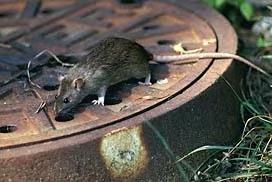
Site and Date of Introduction: Norway rats are believed to have first arrived in the United States on boats around 1776. They were brought over in boxes of grain by Hessian troops who were hired by Britain to fight the American colonists.
Mode(s) of Introduction: Norway rats have primarily been introduced to new areas by being transported on ships in cargo or by stowing away. With increases in trade and new methods of travel, it is likely that they have also been transported on trains and automobiles. They are also excellent swimmers and may have entered new regions through self-propelled swimming. In 1727, large masses of these rats swam across the Volga River and entered into Russia. Migrating rats can swim up to half a mile and survive by treading water for 3 days.
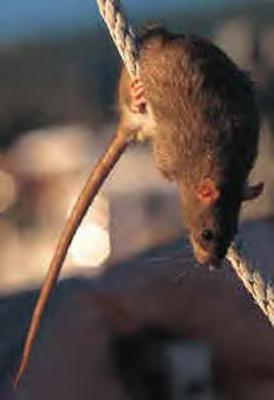
Reason(s) Why it has Become Established: The primary reasons Rattus norvegicus has become established are its high reproductive rates and its association with humans. Norway rats have evolved and adapted to urban areas as a result of their opportunistic and omnivorous behavior. Due to this rat’s large size and aggression, they are strong competitors and tend to displace other rodent species. They can survive in a variety of different habitats and take advantage of shelters and resources provided by vacant buildings, subways, crop fields, and salt marshes. They have also adapted to different climates, which is enabled by human habitation and a constant supply of food. Rat pups have developed a behavior called "huddling" that not only helps them keep warm, but also contributes to the cohesion of their group. In addition, Norway rats are successful edge species preying on bird eggs and other food which allows them to flourish in fragmented habitats.
Within cities, Norway rats are found in the cellars and basements of houses and they thrive in sewers. Though they live in large, closely knit groups, they are conspicuous since they can hide in small places. This species is not entirely released from their natural predators like snakes, owls, hawks, weasels, and minks, but rather domestic cats and dogs prey on rats in cities. However, they have no significant effect on decreasing rat populations. Mortality rates for city rats are high, but they are compensated by high fecundity and the availability hiding places. They build underground burrows with long tunnels and chambers for food storage and nests. Their nests are found either inside or outside, usually located in sewers, storm drains, crawl spaces, storage rooms, and in any cluttered area. To find resources, they will travel up to 2-3 miles, though their normal home range is about 50 meters. Their only limitations are food and water, which they need between 0.5-1 ounce per day to survive. Rats can survive for 14 days without food and will resort to cannibalism if none is available. They will also carry out massive migrations to new areas when crowding occurs, increasing their rate of spread. Once they are introduced to a new area, their populations increase rapidly as they take advantage of nearby resources to reproduce and become established.Ecological Role: Norway rats are nocturnal and omnivorous species who are ground dwellers living mostly in cities and crop fields. They are active all year round and can eat about third of their weight in one day. Food for these rats includes anything from garbage, soap, candy, fruits, grains, seeds and even other rodents and animals. Rattus norvegicus live in large groups ranging from 15 to 220 individuals where there is usually a dominance hierarchy. Their social structure is characterized by a dominant male, who defends his territory and prevents other males from mating, and a harem of females who defend their resources and nests. Norway rats are prolific breeders and will reproduce throughout the year, which is mostly determined by food availability. Females usually have about 7 young per litter and 6-8 litters per year. They also experience a postpartum estrus and are capable of mating 18 hours after giving birth. Young are completely independent after about four weeks and they reach sexual maturity at 3 months. However, males tend to reproduce later when they are larger and can challenge dominant males. Norway rats will reproduce until they are 1.5-2 years old, where the life span is about 3 years old. As a result, their opportunistic behavior and high reproductive rates allow them recover rapidly from disease and control attempts and continue increasing the spread and size of their populations.
Benefit(s): This species has been selectively bred to create the albino lab rat used for research purposes. Some forms of this species are also kept as pets. To a smaller degree, they serve as decomposers in cities by reducing garbage and other food lying around.
Threat(s): Some people consider Rattus norvegicus to be the greatest mammal pest of all time. Currently, an estimated 150-175 million Norway rats live in the United States causing millions in dollars in damage to crops and buildings each year. A U.S. Government report estimated that each individual rat annually damages $1 to $10 worth of food and other material, and contaminates 5 to 10 times more. Using their ever-growing incisors and strong jaws, these rats cause structural damage by burrowing underneath buildings and walkways and gnawing through walls, pipes, and electrical wires. These rats have even started fires by gnawing matches and have caused floods by tunneling through dams. They contaminate crops and food, and may also restrict plant growth by eating large amounts of seeds. More importantly, they transmit diseases directly by biting people and contaminating food, and indirectly by carrying lice and fleas. Historically, they have been vectors for bubonic plague, leptospirosis, typhus, spotted fever, tularemia, salmonella food poisoning, infectious jaundice, and other serious diseases.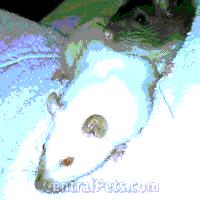
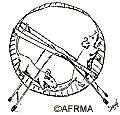
Control Level Diagnosis: It has been recommended that Rattus norvegicus receive high priority diagnosis for control because they are a highly invasive species causing large amounts of damage each year. They have contributed to the extinction and reduction of many mammal, bird, reptile, and invertebrate species through competition and predation. They also pose a threat to human health as vectors of many diseases. Since they are commensal with people, as human population increase, so do the rat populations. Today, there is practically a one to one ratio of people to Norway rats in cities. Thus, Norway rat populations should be closely monitored and eradicated when necessary.
Control Method: A variety of control methods have been used including snap traps, habitat destruction, and chemical control. Some rats have learned to avoid traps, while others have developed resistance to poisons. Another method has involved introducing natural predators like the barn owl to reduce populations. Though there are significant risks in introducing another species into new areas, in Malaysia, introduced barn owls were successful in killing about 1,300 rats a year. The most effective control methods usually include a combination of many techniques. In some areas, it is recommended that people “rat proof” their homes by removing wood piles, keeping their yards cut low, making sure food is stored in safe containers, and filling all interior and exterior holes in buildings to prevent rats in the walls. This includes:
Rodenticides have been the most common control method in reducing rat populations. However, there are many risks in using these poisons indoors. For example, if a rat ingests some poison and crawls back in the walls to die, this could result in foul odors and the arrival of beetles or other insects that will feed on the dead rat. On the other hand, eradication has been successful on some islands using poisons. Despite this, there has been some evidence that they can survive and even adapt to poison. A years ago, Warfarin was developed as a rat poison, but within the year many rats were seen eating it for food. Norway rats can also learn to avoid poison. Even though their eyesight is poor, they have an excellent sense of smell and can detect contaminants in their food at only 0.5 parts per million. Also, the rat's sense of taste is so strong it can detect as little as two parts per million of poison in their food. Thus, to control rat populations, careful monitoring and the use of many different control methods must be used.1. Blocking all openings around pipes, utility lines, and air vents
2. Sealing doors and windows
3. Sealing holes and cracks in the foundation
4. Repairing and sealing all openings on the roof
5. Repairing gnaw holesReferences:
Aguirre, Windsor and Stuart A. Poss. Rattus norvegicus (Berkenhout, 1769). April 23, 1999 (modified February 15, 2000). http://www.gsmf.org/nis/nis/Rattus_norvegicus.htmlPhoto Credits:Ballenger, Liz. The Diversity Web. 2002. The University of Michigan.
http://animaldiversity.ummz.umich.edu/accounts/rattus/r._norvegicus$narrative.htmlGlobal Invasive Species Database: Rattus norvegicus. July 24, 2002. The Invasive Species Specialist Group (ISSG). http://www.issg.org/database/
The Roof and Norway Rat. November, 5, 1999. The Northeast Region Pest Page. http://npspests.cas.psu.edu/articles/RATsheet.html
Schank, J. C. and J.R. Alberts. 1997. Self-organized huddles of rat pups modeled by simple rules of individual behavior. Journal of Theoretical Biology 189: 11-25.
Yom-Tov, Yoram, et al. 1999. Competition, coexistence, and adaptation amongst rodent invaders to the Pacific and New Zealand islands. Journal of Biogeography 26: 947-958.
http://www.terrierman.com/aboutrats.htm
Norway rat courtesy of http://www.discoverlife.org/nh/tx/Vertebrata/Mammalia/Muridae/Rattus/norvegicus/
Norway Rat on sewer courtesy of Ron Austing: http://www.enature.com/fotog/fotog_gallery.asp?fotogID=944
Rattus norvegicus on marine mooring courtesy of www.issg.org.database
White lab rat courtesy of http://www.centralpets.com/pages/photopages/mammals/rodents/PHOTO_ROD1537.php?rate=0&Page=4
Rat cartoon courtesy of http://www.afrma.org/rminfo1.htm